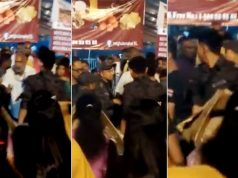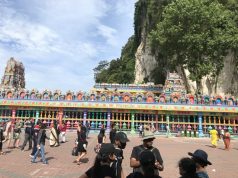KUALA LUMPUR, AUG 13- The dress code imposed by the Batu Caves Sri Subramaniar Temple committee drew brickbats from joggers and devotees alike.
While some argued that it may affect tourist arrival, one even gave spiritual reasons to back his argument.
D Ponranggan, a senior citizen who frequents the temple for prayers, said a man of faith would not be perturbed by people wearing shorts or any other attire.
“Are you telling me that our people are so weak in faith that a man or women in shorts would distract them while praying?” he asked.
Ponranggan, a permanent resident in Malaysia, argued that imposing such a guideline would not give foreigners a good impression of Malaysia as a developing country.
 “Our body itself is a temple and God lives in everyone. So, are we still going to stop ourselves from seeing people in shorts and skirts wherever we go? I think this is not logical,” he said.
“Our body itself is a temple and God lives in everyone. So, are we still going to stop ourselves from seeing people in shorts and skirts wherever we go? I think this is not logical,” he said.
Yesterday, FMT reported that the temple committee has imposed several prohibition on the visitors such as no smoking, running up the steps and spitting as well as barring them from wearing shorts, skirts and having pets with them.
Temple committee chairman R Nadarajah claimed that devotees were feeling embarrassed and uncomfortable to see people wearing shorts and working out in front of the temple when prayers were being conducted.
Ponranggan, however, believes that spitting and littering should be prohibited not only in a temple compound but in all areas.
Another devotee who frequents the temple, Tamilselvi Renggan, was more vocal against the ban. She said many devotees visit the temple may be wearing traditional attire but of the revealing type.
“Even the saree blouses and other traditional clothing worn by these devotees are very revealing.
“If you are going to impose this ban on tourist, how do you expect tourists to know all this when they are not aware of our culture?” asked the 36-year old homemaker.
Rent out proper attires
E Iyappan, a 26-year old Indian national, said he feared such a ban would affect tourists visits to the temple.
He suggested that the temple committee follows the rules of the temples in India where the temple committee provides stalls selling or renting out proper attire for worship.
“How do you expect tourists to know the temple regulations? In India, there are temples which practices strict dress codes but they do have stalls which sells or rents out proper attire,” said Iyappan.
M Krishnan, 54, supported Iyappan’s argument, saying that the temple committee should place stalls providing attires such as dhotis and sarees if they want to impose the ban.
“But these people (temple management) are just making things worse for tourists who are taking the trouble to learn our religion and culture,” he said.
Meanwhile, Abu Lais, 56, a frequent jogger at the area lauded the temple management’s ban and said everyone should abide by the regulations imposed.
“One must always remember that although it is a favourite area for many to workout, it is still primarily a place of worship. Hence, joggers and visitors should respect the code of conduct of any places of worship they step into,” said Abu.
However, he believed that tourists should be given some leeway due to cultural differences.
Another jogger, who wished to be only known as Noraida, said she would abide by any regulations imposed by the temple as a sign of respect.
“I will respect any regulation in a place of worship. However, I don’t think it is logical to impose the ban on tourists as they may not know the rules,” said the 46-year-old.
A florist, who declined to be named, also said the new regulation may affect his business as many tourist purchase garlands, flowers and prayer items from him.
“This ban will affect my business as tourists may stop coming to this place,” he said.
Meanwhile, a check by FMT this morning found that the signboard informing of the ban has been removed by the temple committee.
When asked, the temple committee honorary secretary RT Sundram said they are planning to replace it with a new one to better inform the public.
“The original depicted a person in business attire and many thought devotees had to wear a suit to enter the temple. So, we need to put a better and accurate picture so as to not mislead the public.”











